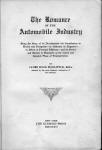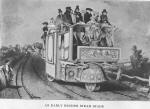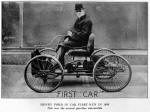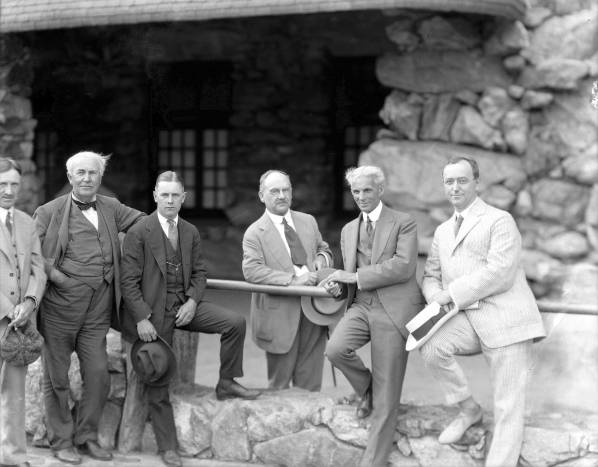| 03 | AUTOMOBILITY |
|
|
|
|
|
| James Rood Doolittle, editor. The Romance of the Automobile Industry: Being the story of its Development -- its Contribution to Health and Prosperity -- its Influence on Eugenics -- its Effect on Personal Efficiency -- and its Services and Mission to Humanity as the Latest and Greatest Phase of Transportation. (1916) was one of many books published in the early years of automobility. | |
|
|
|
|
The Automobile "The automobile is the most important device ever made by man..." said James Rood Doolittle, the editor of The Romance of the Automobile Industry. This large tome attempts to capture the progress of the last ten years of "automobility." Written prematurely in 1916, James Rood Doolittle extols not the mechanics of the machine, but the pleasures and the romance of transportation. At the time that Doolittles' book was published there were close to 4 million cars either scheduled for production or in existence. There were also at least four other books published about automobiles near the same time: Story of the Automobile: Its History and Development from 1760 to 1917, with an Analysis and the Standing and Prospects of the Automobile Industry (1917), by Barber ; The Life History of Automobiles (1926), by Griffin ; A Financial History of the American Automobile Industry (1928), by Seltzar; The Automobile Industry: Its Economic and Commercial Development (1928) by Epstein; and Men, Money and Motors: The Drama of Automobiles (1929), by Macmanus and Beasley; The romance of the automobile has everything to do with the Blue Ridge Parkway, just as it had to do with the Autobahn in Germany and with the Autostrada in Italy. Those fine "today horses" that roar down the Autobahn at speeds sometimes in excess of 100 MPH and the elegant and sleek Italian designer cars and drivers that preen on the Autostrada, are not unlike the fine thoroughbreds and horsemen that paraded through Olmsted's Central Park in New York in the late nineteenth century. Today there are often vintage car caravans, motorcycle groups, camper clubs, etc. These caravans are, in many ways, urban promenades. |
|
|
Some have suggested that the automobile industry was one of the most significant cultural shifts in the world and also one of the most rapidly developed industries in the world. The French were the first to mass produce the automobile. Panhard & Levassor began production in 1989 and Peugeot in 1891. Henry Ford established his Ford Motor company in 1903 and by 1927 there were nearly 15 million Model Ts on the roads of America. The rapid deployment of the automobile was due to the assembly-line production. The Model T took 93 minutes to assemble. But, what about the roads to carry all these automobiles? By 1910 there were nearly 2 million miles of roads in America. The issue, then, was not that there were no roads for the automobile. There were no "good" roads. Early roads in America were a challenge, and contrary to popular belief, there were many of them. In the Encyclopedia of Urban America: The Cities and Suburbs (1998), under "Roads", the editors note that Albert Gallatin, Jefferson’s secretary of the Treasury, "was so unused to the concept of actually building or improving roads in a nation of trails that he called them 'artificial' in his 1808 Report on Roads and Canals." Nevertheless, Gallatin was extraordinarily farsighted, proposing construction of a turnpike from Maine to Georgia, with four cuts from east to west through the Alleghenies. The projected cost was to be $2 million a year [length of time to complete is not described], but Congress rejected his plan due to state rivalries and funding demands created by the War of 1812. Never the less roads were soon being constructed at a rapid pace. [ Retrieved from http://0-www.credoreference.com. wncln.wncln.org/entry/abcurban/roads] In the 1880's, bicycles began to have an impact on the roads of America. Millions of Americans took to the cycle, either the high front wheel version or the new safety model that relied on two equal-sized chain-driven wheels for stability. As the riders became more proficient, the demands for roads that were less confining became more vocal. By 1890 the League of American Wheelmen, an elite cyclist group, became very vocal advocates and took their demands to the local governments of urban communities. Their concern, however, was not just with the roads within their cities, they wanted full access to improved country roads for excursions into the country. Within a "days outing" was the operative phrase. The improvement of roads to this urban leisure class was for their recreation, not for their commerce, or transport of goods to market like the rural farmer. Muddy roads and ruts meant they could not have their "days outing" without getting very dirty. It was the invention of two bicycle mechanics in Springfield, Massachusetts, the Duryea Brothers, that started the automobile industry in America. The two brothers built the first "motor wagon", or gasoline-powered vehicle in America. Henry Ford's first attempt at an auto was his "Quadracycle" built in 1896. It was the invention that led to his assembly-line Model T. |
|
|
But before there were bicycles and before there were automobiles, there were locomotives. It was the railway that established the tourist trade in western North Carolina when the Western North Carolina RR pushed eastward to Asheville from the hub at Salisbury, NC in 1880. By 1882 the WNCRR had extended the line to the Tennessee border and there connected to three other major rail lines. In 1887 the Ducktown extension was complete and the railway provided access to the southwest. By 1886 the rail hub in Asheville gave access to all points on the compass. The railway was completed into western North Carolina just in time to coincide with the opening of the Battery Park Hotel in 1883, the largest hotel of its kind in the southeast. Col. Frank Coxe, the vice-president of the railway that entered the Asheville basin over the crest of the Blue Ridge near Catawba Falls, was also the builder and owner of the Battery Park Hotel. Col. Coxe was the grandson of Tench Coxe, whose enormous landholdings in western North Carolina opened the way to industrial development in this part of the state. It was Col. Coxe who attracted the Vanderbilts to western North Carolina and whose land holdings soon nearly rivaled the scale of his grandfather's holdings. When passengers arrived by train, they generally arrived in Asheville at the Depot located near the French Broad river. From there they were transported to hotels and to tourist destinations by a network of small railways and trolley lines. The street railway system in Asheville was the first electric power railway in North Carolina and one of the earliest in the country. The urban rail networks served both tourist trade as well as basic transportation and freight within the metropolitan area of Asheville. One very popular tourist railway was that which provided services to Craggy Mountain. Chartered in 1889, the proposed 25 mile-long railway never succeeded in reaching its destination, but operated a shorter route to several scenic overlooks on Sunset Mountain above Asheville. The total length of the rail line called the Asheville-Craggy Mountain # 11, opened in May of 1891 and was 2.5 miles in length. W.B Gwyn, president of the venture who had invested in the railway and had avidly promoted the line, lost his investment. The line was extended another 4 miles the next year but never thrived. [See the W.B. Gwyn Collection, Special Collections, UNCA] |
|
|
The urban urge to get the tourist and city-dweller into the mountains was part of Asheville's promotional allure. A 1903 advertisement for the Asheville & Craggy Mountain Railway describes the route:
The early Asheville & Craggy Mountain Railway was an attempt to give access to the scenic beauty of the crest of the mountains. Before the rail line was extended the full length, it traveled as an extension up Sunset mountain and provided several stops of interest to tourists. |
|
|
By the first decade of the twentieth century, automobiles were well established. Publications such as The Carriage Monthly and The Horseless Age also lobbied for better roads, as did the new magazine Country Life in America, a popular serial with wealthy residents in the Asheville area at the turn of the century. Introduced in 1901, Country Life in America was aimed at the affluent who wished to explore suburban living. Originally it was believed that the magazine would appeal to the rural dweller, but soon it was evident that it was the urban dweller who made up the largest readership. The magazine persisted until 1942 and chronicles the remarkable development of the road and the automobile in America. Allan Bussel, faculty at Clark College in Atlanta, Georgia, described the history of the magazine and the technological development, in his paper presented to the Magazine Division, Association for Education in Journalism, August 18, 1975, at Carleton University, Ottawa, Canada. The paper entitled " A Technological Guide to the Suburbs, Country Life in America tells us that by 1907 most of the issue of Country Life in America was devoted to the automobile, signaling the new importance of this mode of transportation for the middle and upper-classes. By 1909 the cost of motoring had sharply gone down and more automobiles were on the road. The marketing of the automobile continued to promote the healthful and relaxing benefits of the machine, its ride, and the many auxiliaries gadgets that could be purchased for the auto. This "gadgetry" suggests that the utilitarian nature of the machine had not yet fully registered. Refrigerators, steam operated calliopes, full bars, compasses, odometers, speedometers and even kid-eradicators --- a special gadget that made sure that kids did not grab onto the back of the automobile to hitch a ride --- were promoted and sold. [Bussle, p. 13] |
|
|
When President Teddy Roosevelt came into office he sought to improve the quality of rural life and particularly its roads. He appointed Liberty Hyde Bailey to manage the Country Life Commission. The most cynical advance that Bailey suggested for rural improvement was the wholesale implementation of adequate pumping systems for household bath systems. It seems that rural people needed to be cleaned up as they "never had the pleasure of knowing "real cleanliness." [Bussle, p.13] Bailey summed up his views by saying, "It does not matter if farms do not make men rich, they make men happy." It was not long before the city dweller found the ideal "farm-park" where he could live out his farm fantasy on the week-end and return to the city during the work-week. Homes along the Blue Ridge Parkway became prime "suburban real-estate" and slowly the real famer was squeezed further and further away from the boundaries of the parkway. Farmers were denied access to transport their crops, cross the parkway to farms on the opposite side of the road, advised to not tamper with view sheds, and taxed at rates unheard of before the coming of the parkway. Bailey's ill-informed efforts to assist the American farmer was just the beginning of many and continuing attempts to integrate rural farm-life with urban leisure-sprawl. It is only recently that there has been progress in this area as more and more agri-tourism is introduced into the region and as local farmers find a ready market in the booming organic farming industry. |
|
|
In the Encyclopedia of Urban America: The Cities and Suburbs,
the early twentieth century road adventures of two Americans,
Horatio N. Jackson and Sewell K. Croker, are described. The
two were the first to complete the travel from the Atlantic to the
Pacific by automobile. Their 4,500 mile trip which was from
west to east (San Francisco to New York City) took 61 days to
complete. The adventure of it all had a strong appeal and
their adventure was quickly replicated throughout the country.
One of the most amazing road adventures and group of adventurers was
the trip from Detroit to Florida, through Asheville, by the
so-called "Vagabonds". The "Vagabonds", Henry Ford, Harvey
Firestone, and Thomas Edison and other tag-alongs would travel from
Detroit to Florida, their summer homes, via Asheville. In a
convoy of automobiles, the group would often camp along the way.
This remarkable road-trip of America's technological elite almost
sounds fabricated, if the proof was not found in the famous
photograph of the group in front of the Grove Park Inn with the
Inn's architect, Fred Seely and the Inn's owner, E.W. Grove.
Reportedly the "Vagabonds" traveled each summer for some 13 years
through Asheville and while here, stayed at the Grove Park Inn.
What better way to promote automobiles, tires, batteries, and other
new technologies, than to actually put them to the test! |
|
|
Roads. (1998). In Encyclopedia of Urban America: The Cities and Suburbs. Retrieved from http://0-www.credoreference.com. wncln.wncln.org/entry/abcurban/roads |
|






